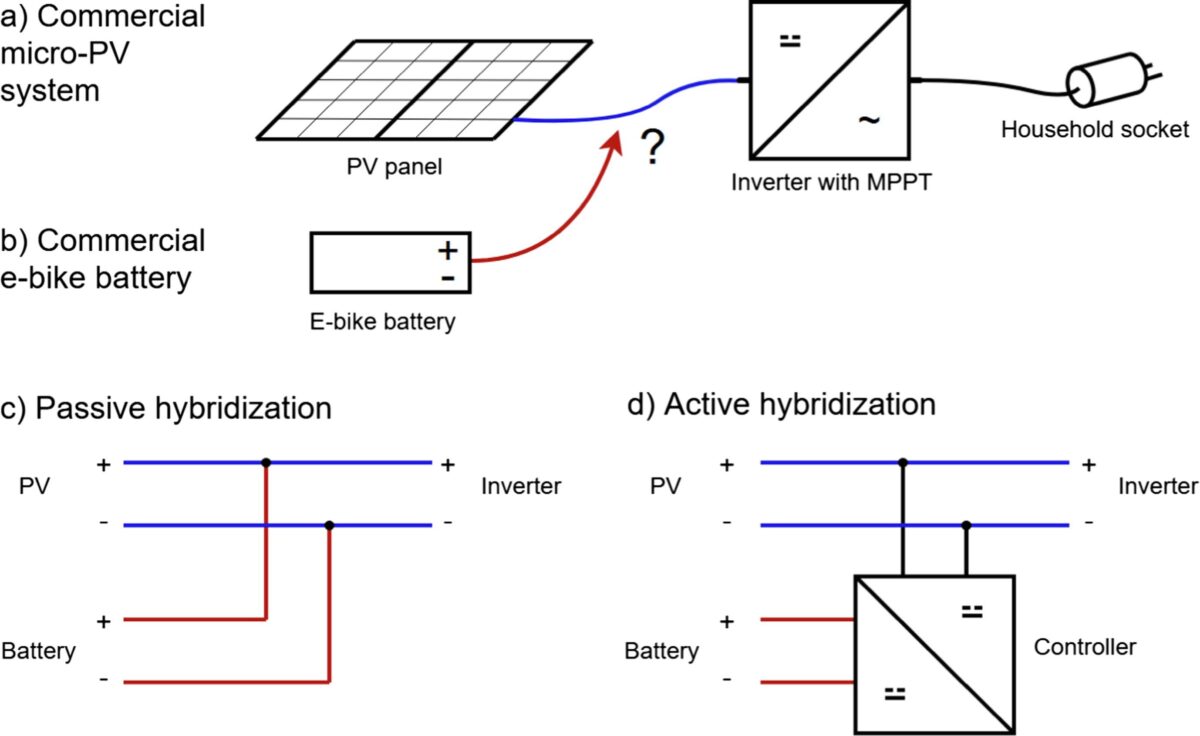Scientists from the Offenburg University of Applied Sciences in Germany have sought to integrate a commercially available lithium-ion battery for e-bikes with a balcony PV system with the aim of assessing potential savings and improvement in self-consumption rates.
Their approach consisted of coupling the battery with the system with a minimal amount of additional components and without any modification, which they said kept the system cost low. They also specified that, in the proposed system configuration, the microinverter does not “know” that it is connected to a battery, which pushed the researchers to investigate the use of passive or active measures to avoid maximum power point (MPP) tracking of the battery.
For this reason, the research group proposed two different system architectures, which it called passive hybridization or direct coupling and active hybridization or active coupling.
With the first one, the battery is connected to the panel without any microinverter or charge controller in between. “It is based on matching the PV and the battery respective current and voltage behaviors,” the scientists said, noting that the system is self-regulated and no battery management system is needed. “During battery charge, the system voltage increases and drives the PV towards zero current when the battery is fully charged. During discharge, a diode protects the PV from too low voltage levels.”
The active architecture implies the connection of a microinverter and a controller between the battery and PV systems, which enables active control of voltages and currents while regulating the interaction between the components. “Here, one side of a controller is placed in the parallel connection between PV modules and inverter,” the academics said. “The battery is connected on the other side of the controller.”
The passive design is cheaper than the active one but is also less efficient than MPP-tracked setups, the group noted.
Popular content
The academics used real weather data and high-resolution synthetic load profiles to conduct a series of simulations via Simulink (MATLAB) to assess the performance of the two systems over a one-year period. They assumed the system consists of three series-connected PV modules with each an output of 100 W, a 36 V electric bicycle lithium-ion battery with a nominal energy of 555 Wh and a nominal capacity of 15.5 Ah, and a 250 W microinverter with an MPP tracker.
They compared the performance of the two architectures with that of a balcony PV system with the same characteristics but without storage. “The three systems were tested on separate days with different meteorological conditions,” they also explained. “For both AC and DC measurements, data was recorded in one-second increments. Weather data were recorded in ten-minute increments.”
pv magazine print edition
In the latest issue of pv magazine we turn the spotlight onto European solar with a comprehensive review of the state of the PV industry across the region’s key markets and a look at the legislation which aims to drive a solar rooftop boom. We also examine the difficulty of establishing a solar panel recycling industry in Australia, where industry backbiting isn’t helping matters.
Through its analysis, the German team came to the conclusion that both the active and passive systems are technically viable as they are able to provide continuous and stable operation over three days. “The passive hybrid system is conceptionally simple and allows continuous inverter operation advantageous to provide household base-load coverage,” it stated. “The active system shows intermittent inverter operation but has higher system efficiencies.”
The scientists said the financial viability of both project designs should be further investigated, as the cost of the battery may still represent a hurdle that may be removed, eventually, by increasing the size of the balcony PV system. “For a broad applicability, the system setup should be adapted for more flexibility, which will probably need to include communication with the battery,” they concluded.
Their findings were presented in the paper “Integration of a lithium-ion battery in a micro-photovoltaic system: Passive versus active coupling architectures,” published in Solar Energy.
This content is protected by copyright and may not be reused. If you want to cooperate with us and would like to reuse some of our content, please contact: editors@pv-magazine.com.



1 comment
By submitting this form you agree to pv magazine using your data for the purposes of publishing your comment.
Your personal data will only be disclosed or otherwise transmitted to third parties for the purposes of spam filtering or if this is necessary for technical maintenance of the website. Any other transfer to third parties will not take place unless this is justified on the basis of applicable data protection regulations or if pv magazine is legally obliged to do so.
You may revoke this consent at any time with effect for the future, in which case your personal data will be deleted immediately. Otherwise, your data will be deleted if pv magazine has processed your request or the purpose of data storage is fulfilled.
Further information on data privacy can be found in our Data Protection Policy.